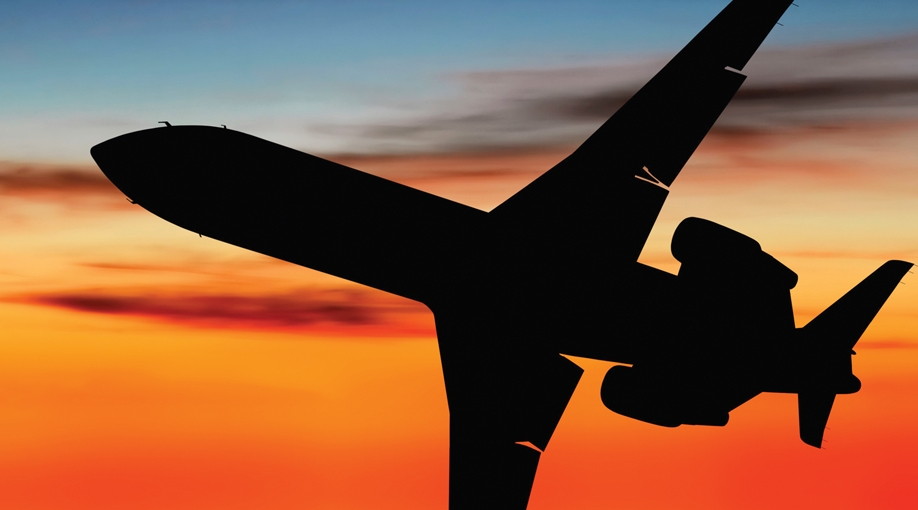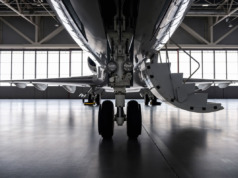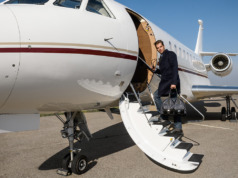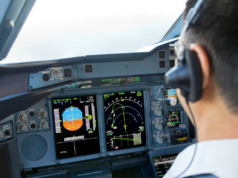
How comfortable are you in your aircraft? No, not in terms of reclining seats and other amenities; rather, how confident are you that you’ll know exactly what to do in case of an emergency?
- Would you know what to do or where to go if the cabin suddenly filled with smoke, in-flight or on the ground? What if your tablet or smartphone becomes overheated and a fire breaks out on the divan? Your first instinct might be to grab the fire extinguisher, but actually, you first should douse it with water to cool down the battery pack.
- Do you even know where the fire extinguisher is located, how and when to use it? Can you recall which direction you need to pull the emergency window handle to open the over wing exit?
- Are you or someone else onboard (other than the pilots) trained in CPR, and in the use of a defibrillator, if your aircraft is so equipped?
- Are you aware that if you close the door between the main cabin and the cockpit prior to takeoff due to noise, you may be blocking your potential exit from the aircraft? In addition, having that door closed during takeoff and landing could potentially block the crew from gaining access to the cabin if they’re needed to assist you. Have you practiced opening the main cabin door?
You’ve heard the safety briefings on commercial aircraft; how do they apply to your aircraft? Since business aircraft configurations and sizes are radically different than commercial aircraft, it’s vitally important to take time to understand these differences. The more knowledgeable you are about the cabin of your aircraft, the safer you, your guests, and your crew will be.
After the safety briefing, passengers often say nonchalantly “I’ll follow you” or “I’m sure you’ll take care of it” to the crew member. In fact, whether your aircraft is a single or dual pilot operation, the crew’s primary responsibility is to fly and land the aircraft. This is particularly true in an emergency situation. In many instances, the cockpit crew does not survive an accident or they may be trapped in the cockpit. In such a case, you and your guests could be on your own trying to find your way to safety.
In a 2004 high-profile accident in Montrose, CO, the Captain, Flight Attendant, and the young son of the charterer of the aircraft all were killed. According to the NTSB investigation, the teen was found underneath the wreckage, having been thrown from the aircraft, as a result of not using his seat belt. His older brother pulled their father out of the aircraft to safety.
Obviously, no one likes to think about this kind of emergency. But, just as with other precautions you take in all areas of your life, there are several about which you need to know when you fly.
- You and your guests should be familiar with these items when onboard your aircraft:
- Emergency exit locations and how to open the doors and windows
- Fire extinguisher locations and how to operate them. Do you have smoke hoods? Do you know what they are and how to use them?
- Life jackets locations and how to put them on. They are not always under the seat like on a commercial aircraft. Where are they on your aircraft?
- Life rafts location and how to inflate them. Does your aircraft even carry a life raft?
- Oxygen masks drop down in case of a change in cabin pressure. Do you know how to use them, and what to do if yours doesn’t drop?
- Bags and any heavy loose objects must be secured for take-off and landing.
- Seat belts are used for take-off, landing, and turbulence.
Many Fortune 100 companies now train their executives and employees to be able to perform and operate safely in all environments – whether in an office on the ground, with fire and earthquake drills or office lockdowns, or in the extension of their offices, on the aircraft. Many organizations require their frequent fliers to take a course annually to ensure their safety. Why not ensure that you, your staff, and your family are trained and educated to the highest level when it comes to your own safety?
Several organizations offer specific training opportunities to aircraft owners and/or executives at locations that meet your needs. These organizations understand that your time is valuable, and offer half-day courses, which literally may save your life.
AirCare FACTS offers the “Executive Frequent Flyer Training” at five locations in the U.S., plus Paris and Amsterdam. The AirCare FACTS training covers aircraft emergency equipment and procedures, and “integrates the human factor elements of flying and air travel safeguards,” intended to build your knowledge and confidence. Aircare FACTS has a mobile simulator, allowing you to experience movement and realistic scenarios at your location.
FlightSafety International “Executive Emergency Training” courses provide hands-on experience specifically oriented towards owners and passengers of business aircraft. Offered at locations worldwide, or onsite at your location, this training is particularly valuable for flight operations that do not use an emergency trained cabin crew member. Instruction includes the use of emergency equipment such as aircraft exits, fire extinguishers, oxygen equipment, life vests, and life rafts. It uses the same training devices used by corporate cabin trainers, aircraft fire trainers, and egress trainers for corporate air crew emergency training classes.
Sajet Solutions offers the “SMART Traveler: Cabin Safety for Business Aviation Passengers” course. Held at the location of your choice and designed to meet your specific needs, this course seeks to “enhance the safety mindset and culture of the traveling professional.”
Just like driving a car, owning, leasing, or chartering an aircraft requires you to follow the “rules of the road,” issued by the Federal Aviation Association. Obviously, there are neither “Air Police” who pull you over to see if you are wearing your seat belt, nor an “Air 911” to call for emergency services. However, if in the unthinkable event that an accident or incident does occur, will you be able to say definitively that you did all you could to ensure that you and your passengers were safe? BAA
Amy Nelson, a Cabin Manager Specialist, was the Manager of Cabin Services at TAG Aviation USA and most recently Flight Attendant Supervisor at ConocoPhillips Alaska. She holds a master’s degree from Embry Riddle Aeronautical University.




